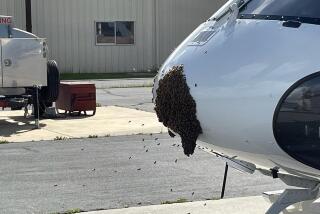Bees May Be Used to Detect Land Mines
- Share via
RICHLAND, Wash. — Honeybees equipped with radio tags no larger than a grain of rice may one day be used to detect land mines on battlefields and elsewhere.
As farfetched as it might seem, a collaborative project seeks to train and track entire colonies of bees that may be conditioned to prefer something other than honey, such as TNT, the primary component of land mines.
Ultimately, it may be possible to carry a hive to a site and release the bees to search for explosives or other things, such as methamphetamine-making ingredients or nuclear waste, said Ron Gilbert, who works on electronic systems at the Pacific Northwest National Laboratory here.
“This system is not unique for land mines,” he said.
The project, led by University of Montana entomologist Jerry Bromenshenk, depends on several factors--particularly whether bees can smell and be taught to find TNT.
“It’s amazing what you can train a bee to do,” said UM postgraduate student Bob Seccomb, who took part in a media demonstration with the bees. “We’ve got them flying through mazes.”
The Red Cross estimates there are 80 million to 120 million land mines in 70 countries around the world and that 60 people a day are killed or maimed by buried mines. In some developing countries, thousands of acres of productive land are unusable because they are death traps.
If the bees can indeed be trained to seek out explosives, the next step is to find a way to track them.
That’s where the radio tags come in. Several years ago, PNNL developed a first generation of radio-frequency tags for the garment industry to track inventory. The tags are similar to the microchips implanted by veterinarians as permanent identification for cats and dogs.
The researchers brought some 20,000 bees in two hives to Richland for three days of tag testing, which ended May 22.
UM student Jason Volkman carefully glued the tiny tags to the bees. To make them easier to work with, he chills the bees in a small refrigerator for four minutes, then attaches the tags to the bees’ abdomens with tweezers.
The tags have a 10-character code that identifies each bee individually. The tags are read by sensitive instruments, attached to a portable hive, which record when the bees leave to forage, the direction they go and when they return.
A special spectrometer would be installed in the hive to “sniff” the bees for TNT residue.
Bromenshenk has characterized the bees as “flying dust mops,” picking up samples everywhere they go. Land mines leak small amounts of explosives into nearby soil and water, and the TNT residue eventually appears in some plants.
In the tag tests, researchers learned that the bees were not dissuaded from returning to the hive by the radio-tag reading equipment, Gilbert said. They also found that the 27-milligram tags they planned on using were a little too heavy for the bees; 25 mg is better.
“We know how to make them lighter,” he said.
The Sandia National Laboratories in New Mexico, the Oak Ridge National Laboratory in Tennessee and the U.S. Environmental Protection Agency also are part of the project, paid for by the federal Defense Advanced Research Projects Agency.
More to Read
Sign up for Essential California
The most important California stories and recommendations in your inbox every morning.
You may occasionally receive promotional content from the Los Angeles Times.













